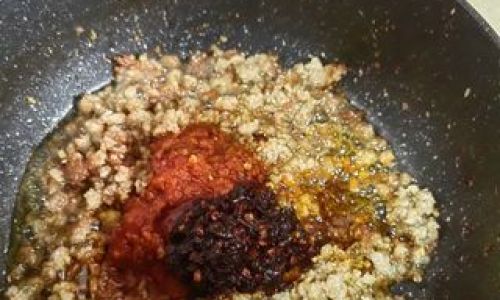Introduction
In the vast culinary landscape of China, Zhajiang (or Zhajiangmian, meaning noodles with meat sauce) stands out as a dish that combines the simplicity of ingredients with the complexity of flavors. This beloved dish, often associated with Beijing cuisine, is characterized by its rich, savory, and slightly sweet meat sauce that perfectly complements the soft, elastic noodles. While the basic recipe may seem straightforward, achieving that perfect balance of flavors that makes Zhajiang truly delicious requires a blend of precision, patience, and a touch of culinary creativity. In this article, we’ll delve into the intricacies of how to make Zhajiang sauce that will elevate your noodles to a gourmet experience.

Understanding the Ingredients
Before diving into the cooking process, it’s crucial to understand the key ingredients that form the backbone of Zhajiang sauce. The sauce typically consists of pork mince (though beef or chicken can be used as alternatives), soy sauce, sweet bean sauce (tianmianjiang), fermented black bean sauce (doubanjiang), garlic, ginger, scallions, and a variety of spices. Each ingredient plays a vital role in creating the sauce’s unique taste profile.
- Pork Mince: Provides the meatiness and umami.
- Soy Sauce: Adds saltiness and depth.
- Sweet Bean Sauce: Introduces sweetness and a glossy texture.
- Fermented Black Bean Sauce: Offers a tangy, savory flavor with a hint of heat.
- Garlic and Ginger: Enhance the aroma and provide a subtle heat.
- Scallions: Add freshness and a mild onion flavor.
- Spices: Such as star anise, cinnamon, and Sichuan peppercorns, contribute complexity and warmth.
Preparing the Ingredients
-
Meat Preparation: Start by finely chopping the pork mince. While ground pork can be used, hand-chopped meat tends to have a more tender texture and better flavor retention.
-
Aromatics: Peel and finely mince the garlic and ginger. Slice the scallions into thin rounds, separating the white and green parts for later use.
-
Sauces: Measure out the soy sauce, sweet bean sauce, and fermented black bean sauce. It’s essential to use high-quality sauces to ensure the best flavor.
Cooking the Sauce
-
Sautéing Aromatics: Heat a generous amount of oil in a wok or large skillet over medium-high heat. Add the minced garlic, ginger, and the white parts of the scallions. Sauté until fragrant and slightly golden, about 1-2 minutes. This step is crucial for building the sauce’s foundational aroma.
-
Browning the Meat: Push the aromatics to the side of the wok and add the pork mince to the center. Break it up with a spoon and cook until browned all over, stirring occasionally to prevent sticking. This process should take about 5-7 minutes. Browning the meat not only adds flavor but also helps to render out excess moisture, ensuring a thicker sauce.
-
Adding Seasonings: Once the meat is browned, stir in the soy sauce, sweet bean sauce, and fermented black bean sauce. Mix well to coat the meat evenly. At this point, you can also add a splash of Shaoxing wine (or dry sherry as a substitute) to deglaze the wok and add an extra layer of flavor.
-
Simmering with Spices: Add a piece of star anise, a small cinnamon stick, and a pinch of Sichuan peppercorns to the wok. Lower the heat to a gentle simmer and let the sauce cook for about 15-20 minutes, stirring occasionally. The spices will infuse the sauce with warmth and complexity.

-
Adjusting Consistency and Taste: After simmering, taste the sauce and adjust with additional soy sauce or sugar if needed to balance the flavors. If the sauce is too thin, you can thicken it with a cornstarch slurry (mixed cornstarch and water). Remember, Zhajiang sauce should be thick enough to coat the noodles generously.
-
Finishing Touches: Remove the whole spices (star anise, cinnamon stick) before serving. Stir in the green parts of the scallions for a fresh burst of flavor. If you prefer a bit of heat, you can also add a dash of chili oil or finely chopped fresh chilies.
Serving Zhajiang
The beauty of Zhajiang lies in its versatility. It’s traditionally served over boiled Chinese noodles, but it can also elevate other dishes like rice, steamed buns, or even as a dipping sauce for dumplings. Here’s how to serve it perfectly:
-
Cooking the Noodles: Boil fresh or dried Chinese noodles according to package instructions until al dente. Drain and rinse with cold water to prevent sticking.
-
Assembling the Dish: Place a portion of noodles in a bowl and top generously with Zhajiang sauce. Garnish with chopped scallions, a sprinkle of sesame seeds, and a drizzle of chili oil if desired.
-
Serving Suggestions: For a more complete meal, serve Zhajiang with sides like pickled cucumbers, steamed greens, or a simple tofu salad.
Conclusion
Making delicious Zhajiang sauce is an art that combines precision in measurement, patience during cooking, and creativity in flavor balancing. By understanding the role of each ingredient and carefully following the cooking steps, you can create a sauce that is both authentic and delightful. Whether you’re serving it to family at home or impressing guests at a dinner party, Zhajiang is a dish that promises to satisfy both the palate and the soul. So, roll up your sleeves, heat up your wok, and embark on a culinary journey to master the art of making Zhajiang that will leave everyone asking for seconds. Happy cooking!






0 comments